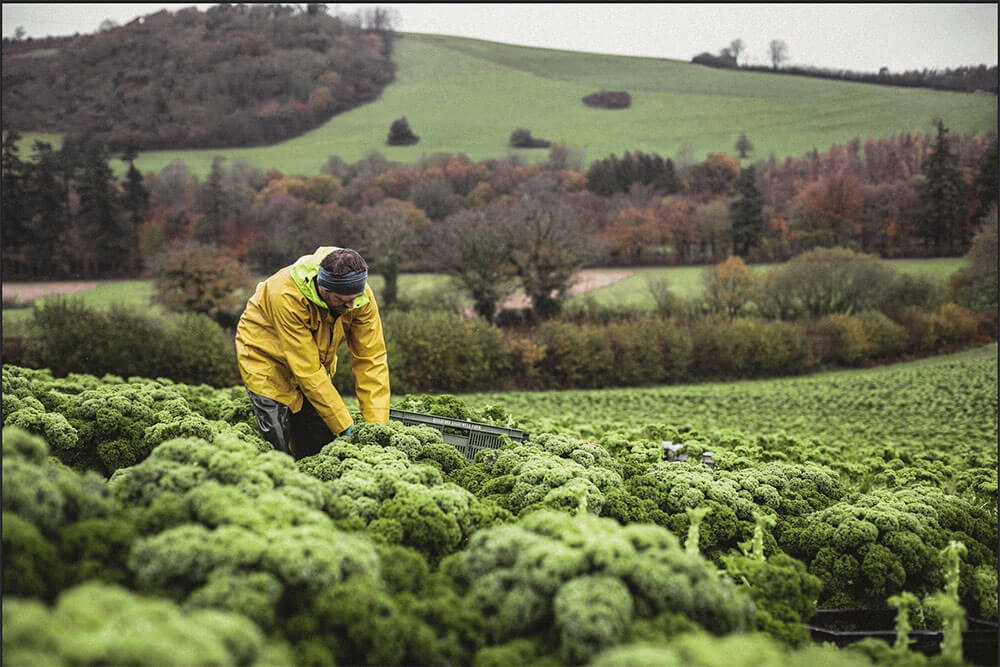
In the kitchen
How to store Kale
Keep in the fridge. Red Russian should last for 3-4 days, curly 4-5 days and Cavolo Nero (black kale) can last up to a week.
Prep & Cooking tips
Wash the leaves in plenty of water, leaving them to soak for a bit so that any grit can sink to the bottom. Curly kale and Cavolo Nero can have tough stalks - if you need to remove them, hold the stalk with one hand and with the other, strip the leaves away. If you'd like the extra fibre, slice the least tough stalks thinly, add to your pot earlier and cook for longer than the leaves.
Kale can be used raw in salads and smoothies, but is most commonly wilted as a simple side, or added to a soup or stew. Steamed, boiled or wilted in a pan, it won’t need much more than a few minutes on the heat. Excessive cooking will generally result in soggy greens, apart from Cavolo Nero, which can survive a long, slow cook.
Easy ideas
1. Raw
All the rage of late, especially in green smoothies. It can make a simple salad folded with a punchy dressing of buttermilk or yogurt, spiked with garlic, lemon juice, fresh herbs and olive oil. ‘Massaging’ the leaves with a little oil and salt prior to dressing has a tenderizing effect. A simple pesto of raw kale, nuts (pine nuts, walnuts, hazelnuts or almonds would all work), parmesan, garlic and olive oil is great with pasta, dolloped into a stew or onto bruschetta. Just blend everything together or pound it in a pestle.
2. As a side
Steamed, boiled or wilted in a pan, it won’t need much more than a few mins on the heat. Any excessive cooking will result in soggy greens. A little garlic and squeeze of lemon rarely goes wrong, but it can happily be enriched with a dash of cream and a little parmesan. Its rapid cookability also lends itself to the stir-fry treatment; a little chilli, ginger and a shake of the soy bottle make for a swift side plate.
3. The finishing touch
Kale won’t weep too much water as it wilts, like spinach or chard, so is easy to add to a dish at the end of cooking for a flash of green. Stir into risottos, hearty ribollita-style stews and pasta dishes for the final 3-4 mins of cooking.
Goes well with
Acidic flavours (Lemon, Vinegar)
Dairy (Cream, Hard cheese)
Pork (Bacon, Chorizo, Sausage)
Chilli
Eggs
Garlic
Mustard
Nutmeg
Nuts
Dried fruit
Kale recipes
-

Kale: Quick Tips
Serves: 4 Total time: 1h 40 min
-

Cauliflower and coconut laksa with kale and rice noodles
Serves: 2 Total time: 45 min
-

Baked potatoes with cheesy kale filling
Serves: 4 Total time: 2h
-

Kale chips
Serves: 4 Total time: 10 min
-

Sausage, kale and barley stew
Serves: 4 Total time: 1h
-

Venison, kale and mushroom stroganoff
Serves: 2 Total time: 40 min
In the field
-

Meet the grower: Andy Hayllor , Ashburton, Devon
As a founder member of the South Devon Organic Producers co-operative, Andy Hayllor supplies Riverford with brilliant organic vegetables.
UK seasonality
Kale varieties
-

Cavolo Nero (black kale)
Its origins lie in southern Italy. It has dark, beautifully blistered leaves and a good robust texture. Black kale is fantastic in peasant soups, ribollita, risotto and pasta dishes, and can survive a much longer cooking time. Or just dress with a chunk of butter, a squeeze of lemon and a bit of pepper.
-

Buttonhole
Buttonhole kale has dark green, frilly outer leaves enveloping a vibrant purple heart. Its stems are succulent, the leaves retain their texture (and some of their eye-catching colour) when cooked, and the flavour is beautifully mild and sweet.
-

Curly kale
Possibly the best known of all the kales, with curly leaves and a slightly peppery taste. Great for blanching or using thinly sliced in salads. Can also be briefly roasted with a little oil and salt to make an alternative to crisps or as a deeply savoury topping for stew.
-

Hungry Gap
Named for the period after winter crops have dwindled, but before spring crops are ready to harvest, this variety has tender fronds on a robust rib, bursting with character and flavour.





